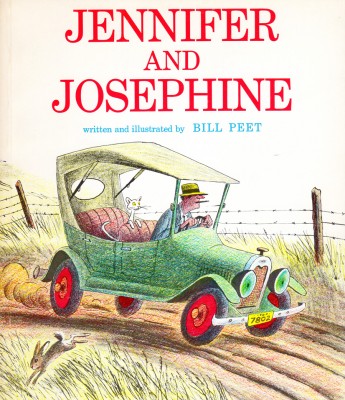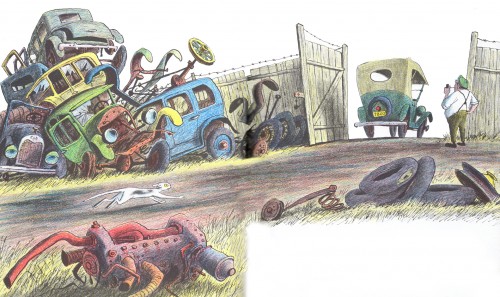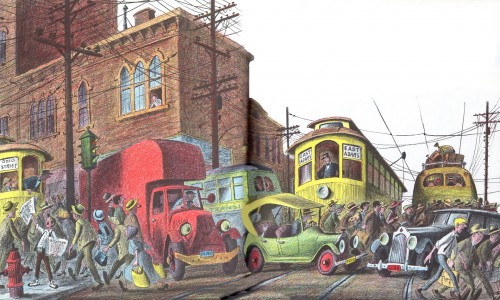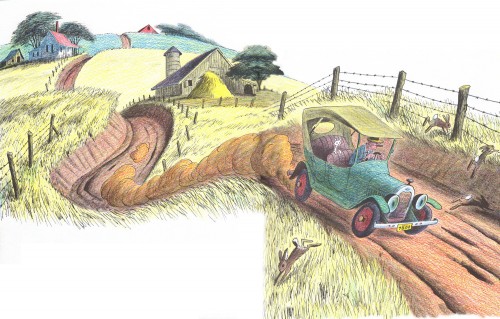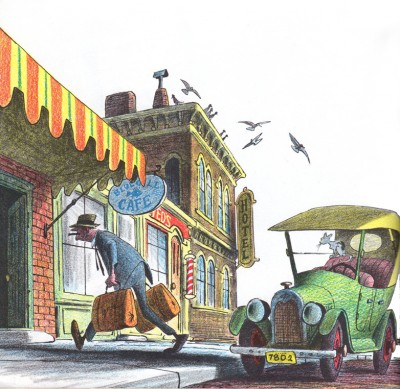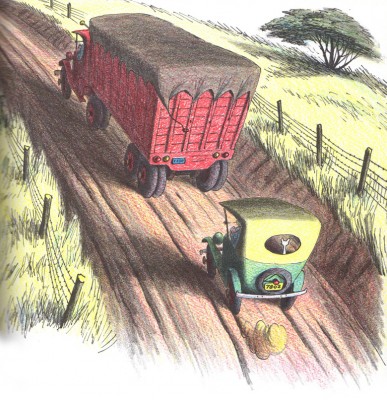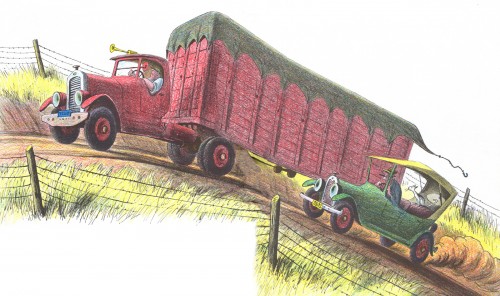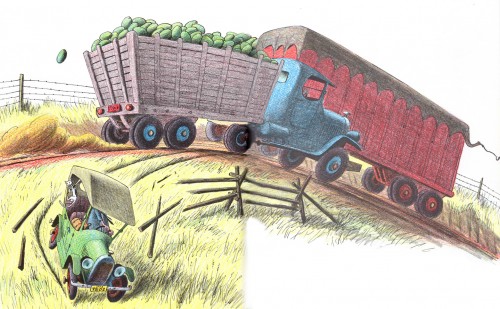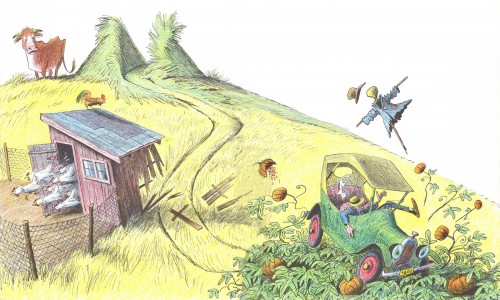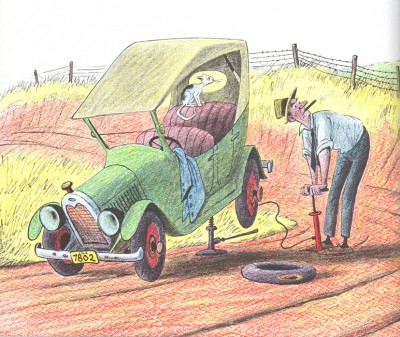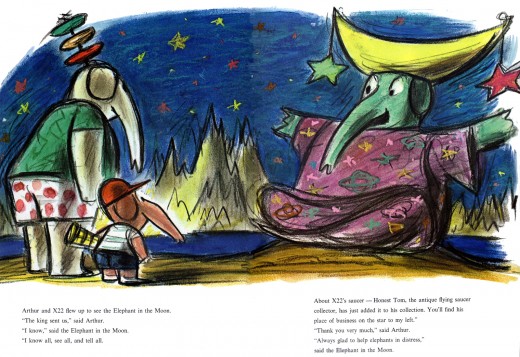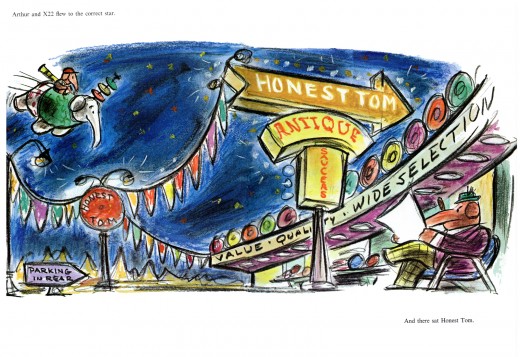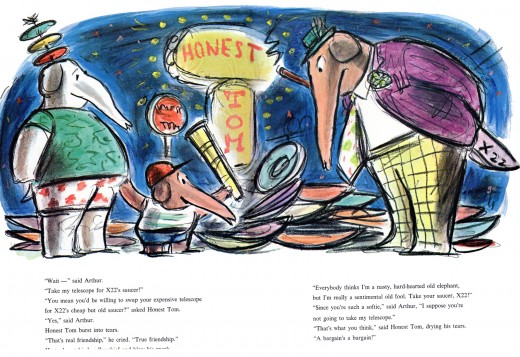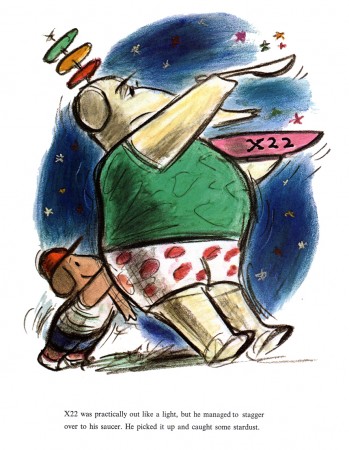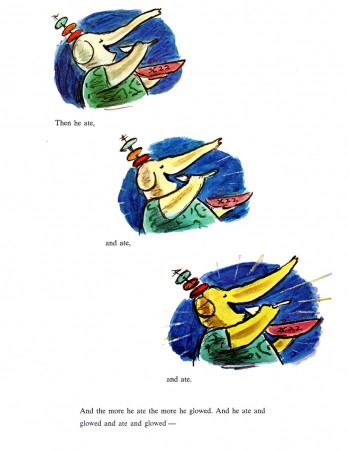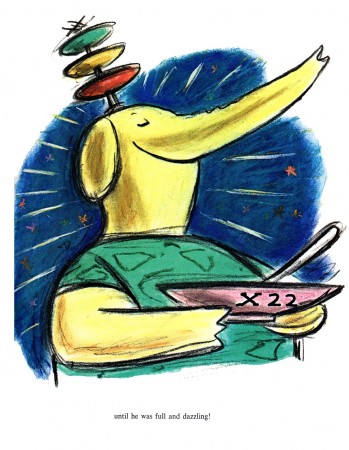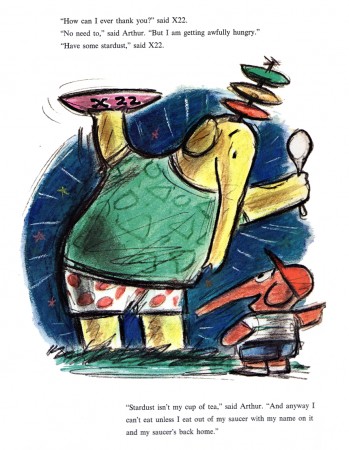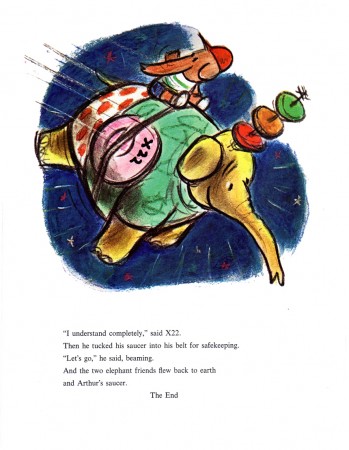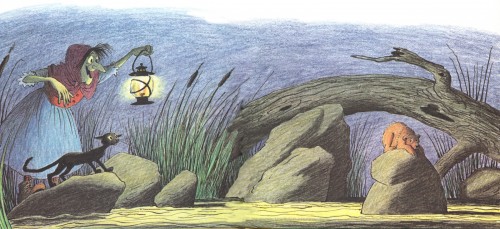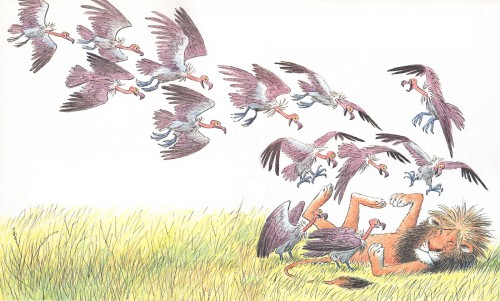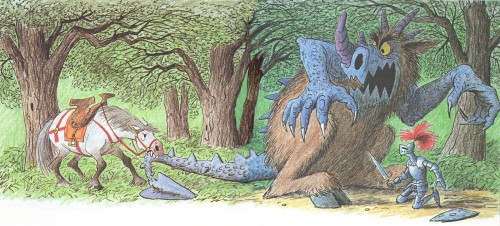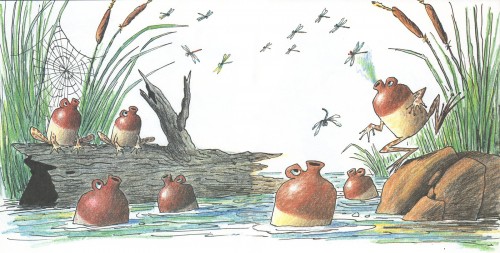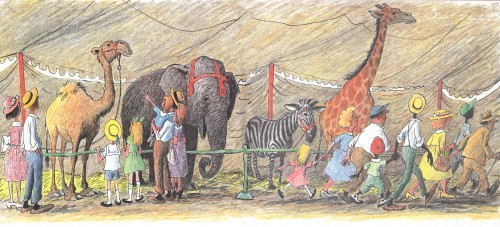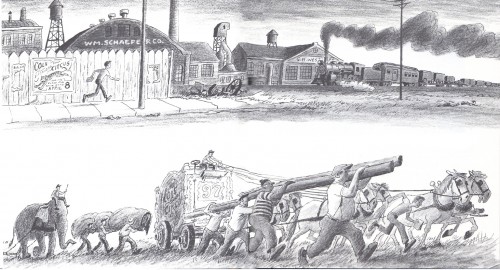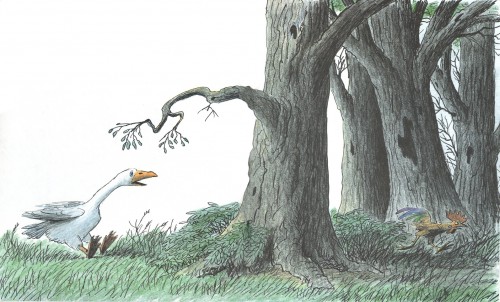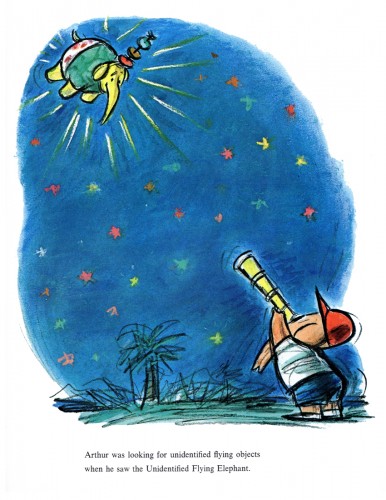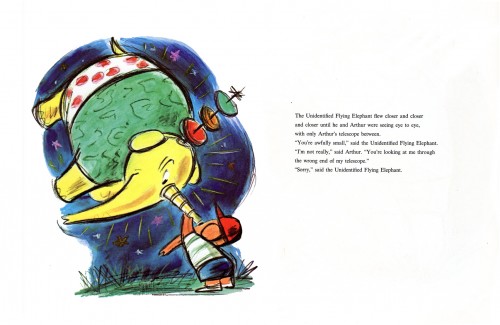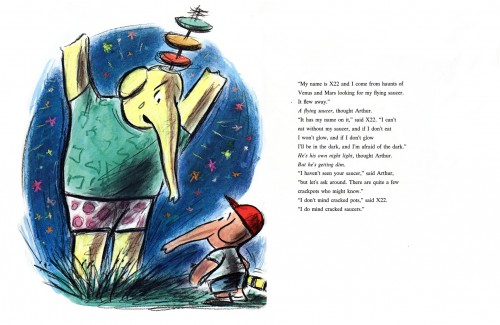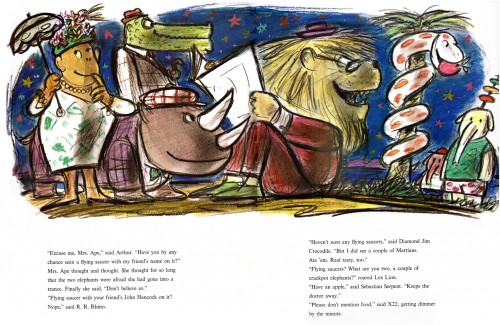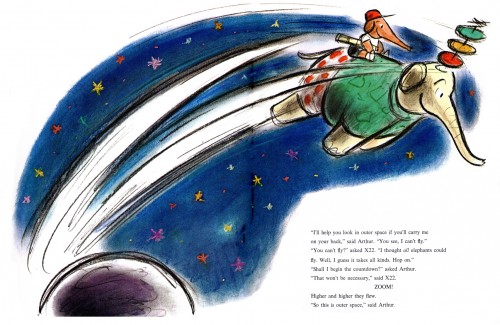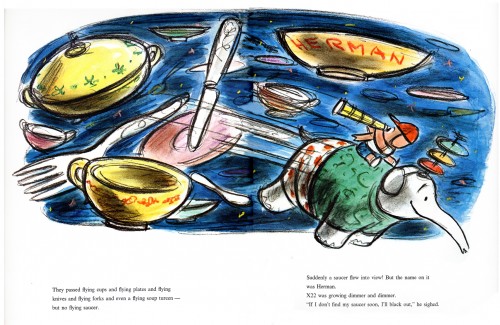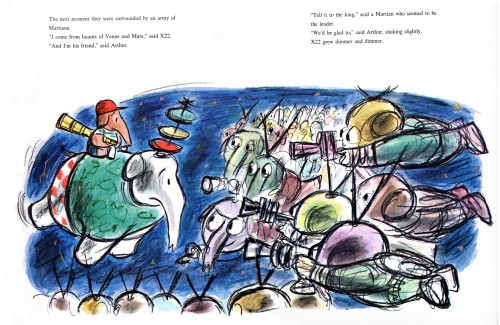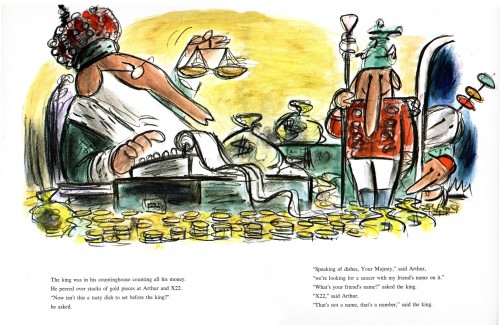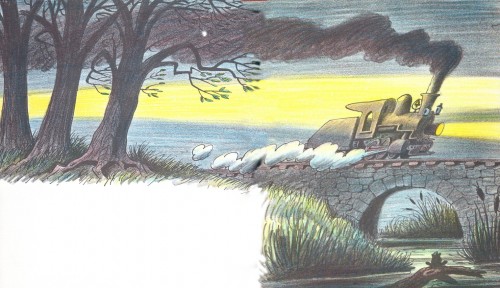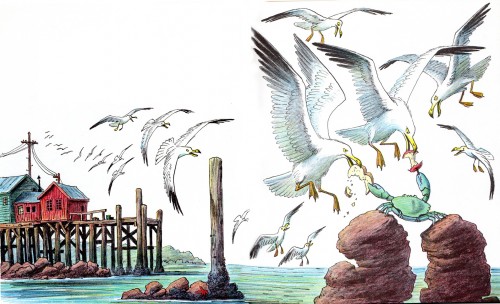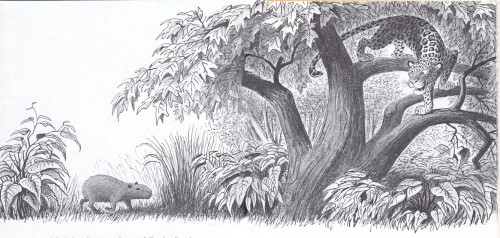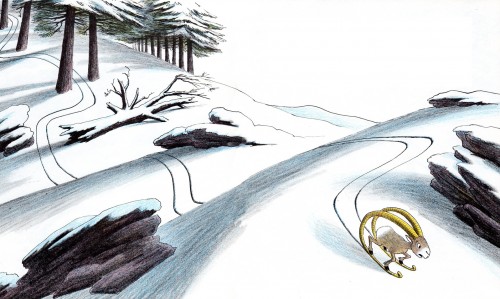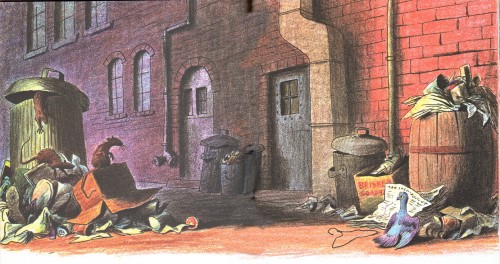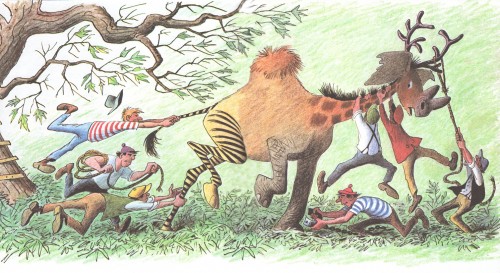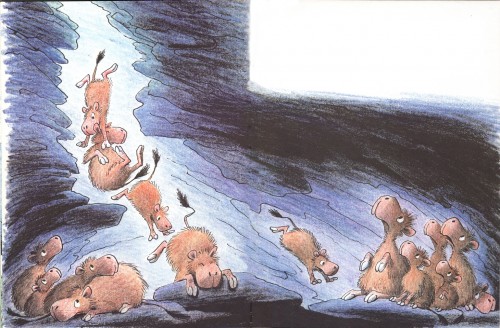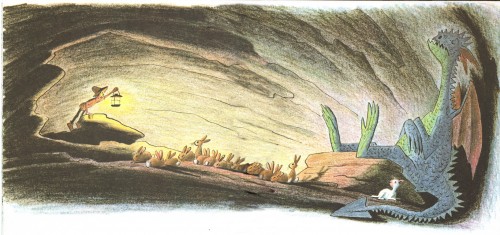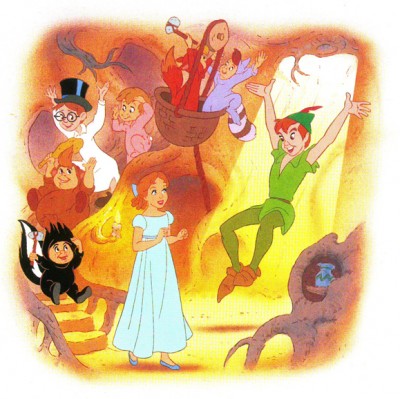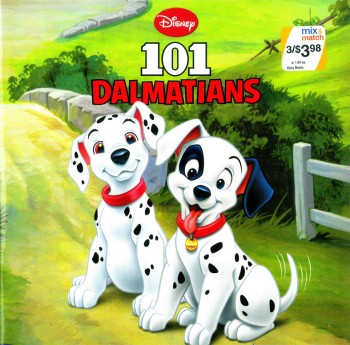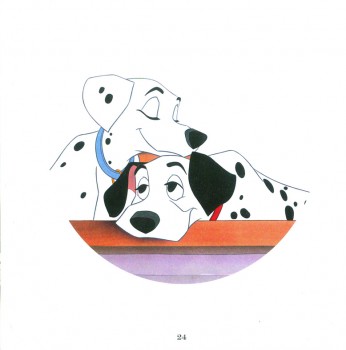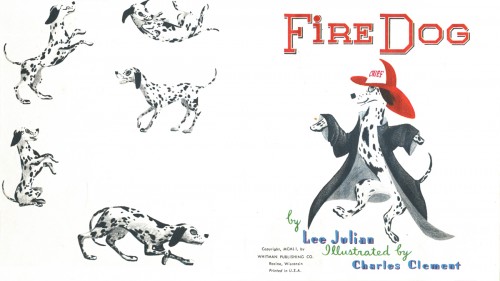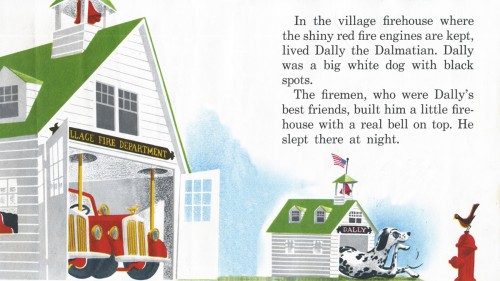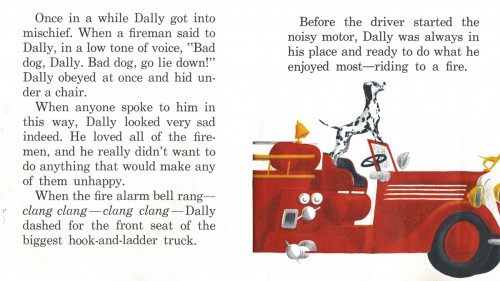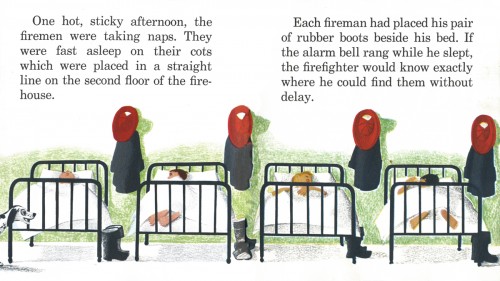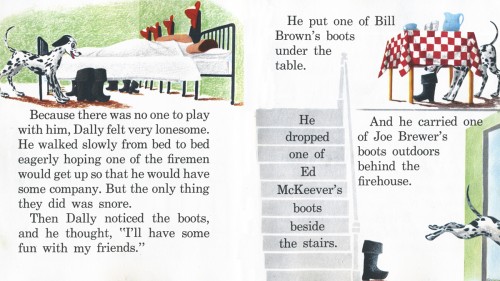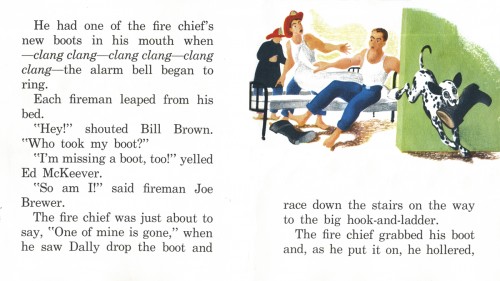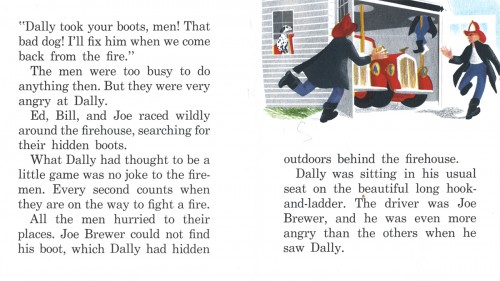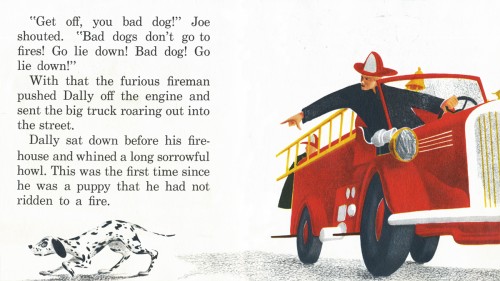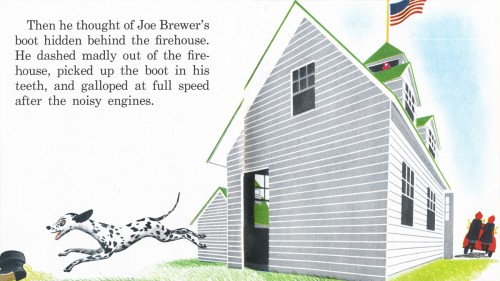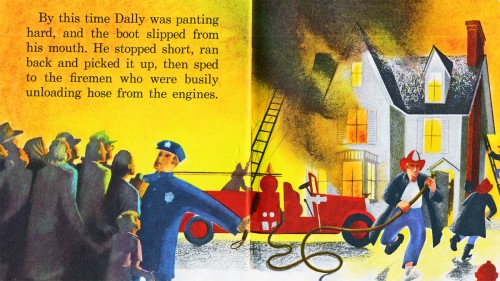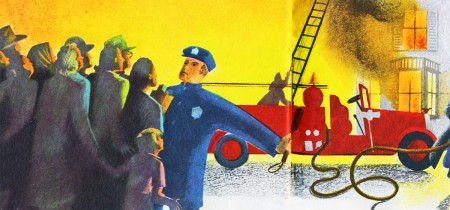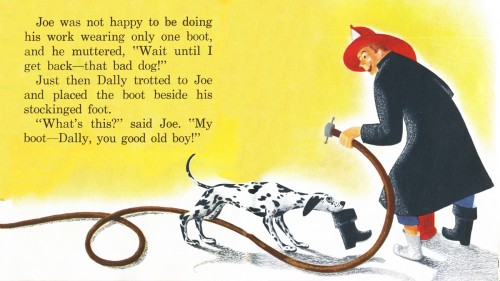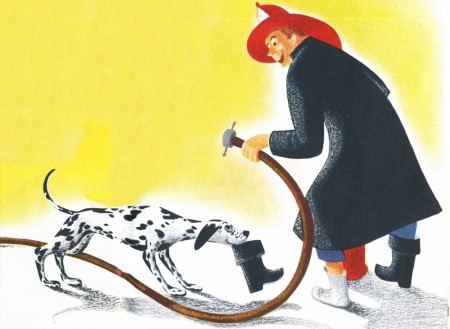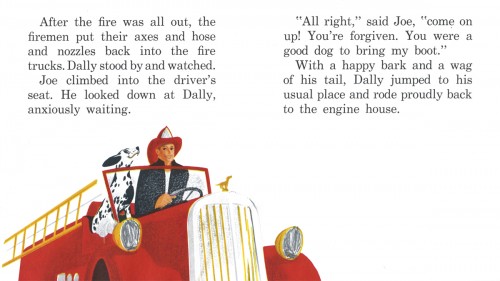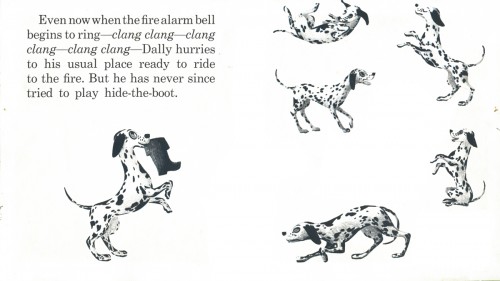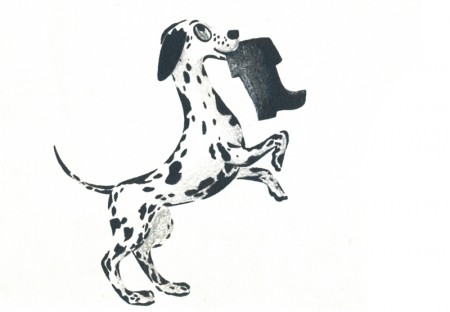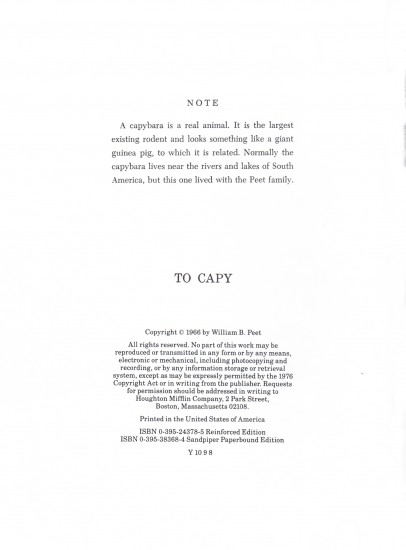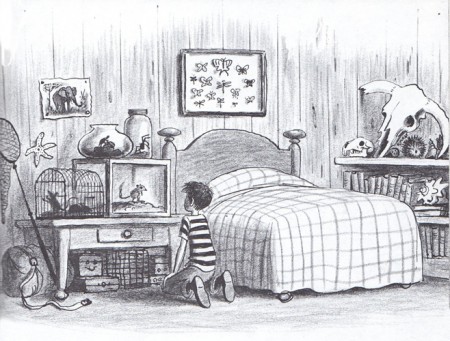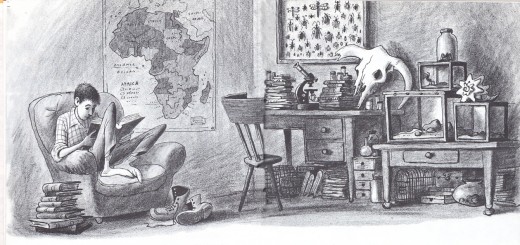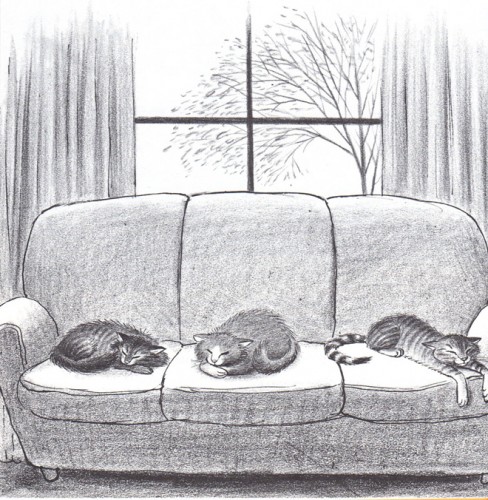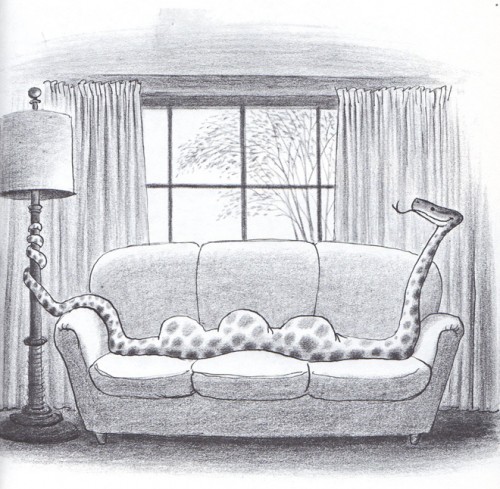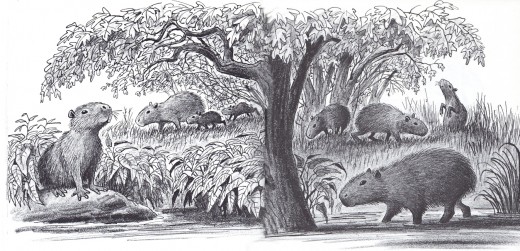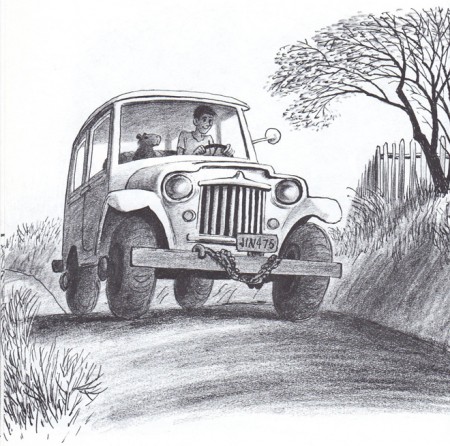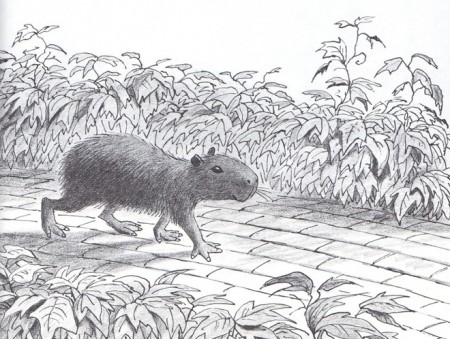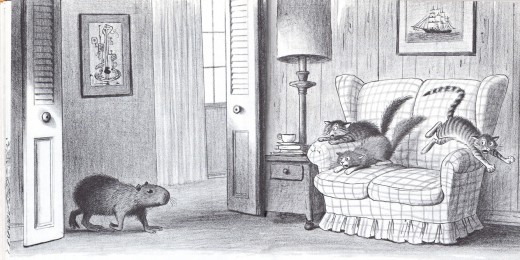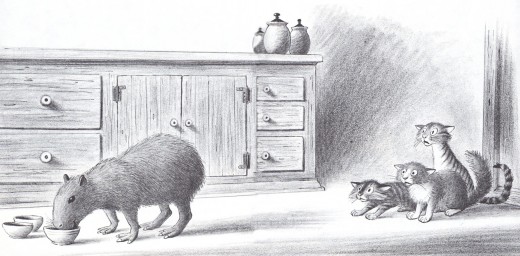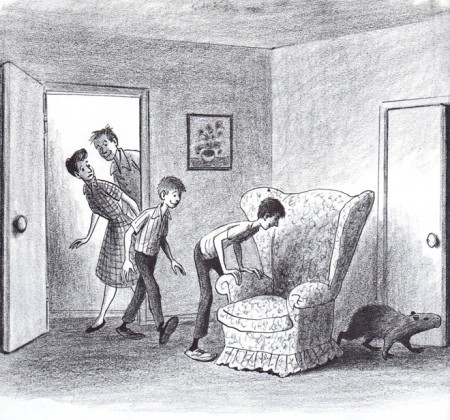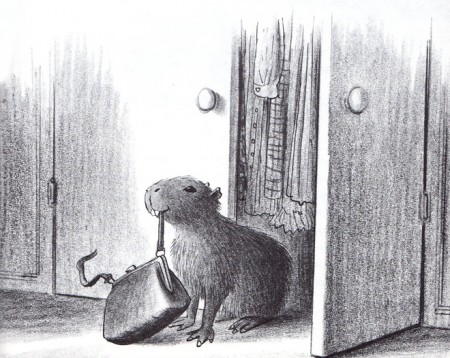Category ArchiveBooks
Art Art &Bill Peckmann &Books &Illustration 08 Apr 2011 07:17 am
Peet Row
On posting some of Grant Wood‘s illustrations last weeik, Eddie Fitzgerald commented that:”‘Death on the Ridge Road’ might have been the inspiration for one of my favotite Bill Peet illustrations in (I think) ‘Chester the Worldly Pig.’†Bill Peckmann pointed out that the book is probably not “Chester the Worldly Pig” but “Jennifer and Josephine.”
Bill’s scanned a good half of the book’s illustrations leading up to the point where the Wood painting and the Peet illustrations come close to matching. It’s good to see what was so obviously Peet’s influences.
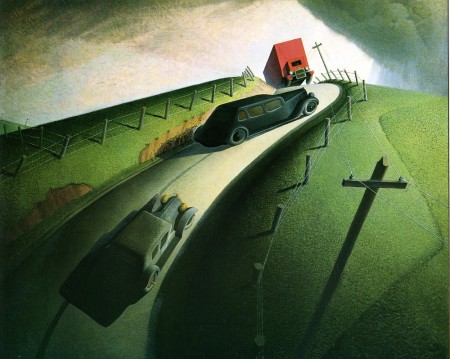
Grant Wood’s DEATH ON RIDGE ROW.
Thanks go to Eddie Fitzgerald for the reference in the comments.
A bigger thanks goes out to Bill Peckmann for the search and the scans.
Bill Peckmann &Books &Illustration 07 Apr 2011 07:34 am
The Unidentified Flying Elephant – pt. 2
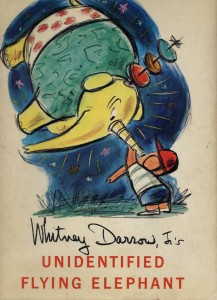 - – Here’s the last half of Whitney Darrow Jr.s book, The Unidentified Flying Elephant. (To view Part 1, go here.)
- – Here’s the last half of Whitney Darrow Jr.s book, The Unidentified Flying Elephant. (To view Part 1, go here.)
The book is a gem from Darrow who was a longtime cartoonist for The New Yorker Magazine. Perhaps in an upcoming post I should showcase some of those cartoons. I have a number of them lying about the studio. His brilliant laine work makes it a learning lesson just to view them.
This book comes courtesy of Bill Peckmann, and I’m most grateful.
Hope you enjoy it.
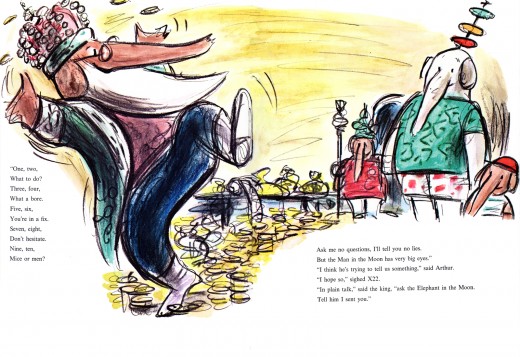
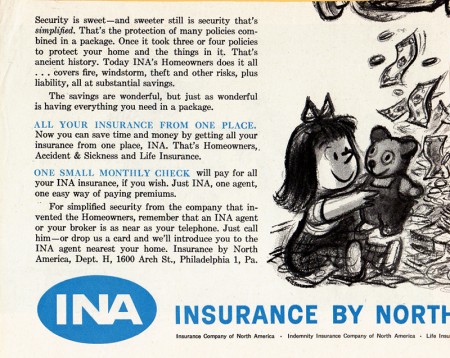
As a bonus, here’s a clip from The Saturday Evening Post circa 1960.
Part of an ad done by Whitney Darrow Jr. for an insurance company.
Bill Peckmann &Books &Peet 05 Apr 2011 07:06 am
Peet’s Capyboppy – Part 4
- Bill Peet‘s Capyboppy was published in 1962. It’s one of the best examples of his book illustrations. The images are all B&W and are strong drawings, all.
The book feels like a close relative to Bill Peet: An Autobiography. (For those of you in animation, you ought to have a copy of this book on your bookshelf. It’s one of the finest biographical books by an animation veteran, and it’s completely illustrated by him. It’s an original.)
Once again, I don’t post Peet’s writing; you’ll have to get the book for that (and it’s worth it.) I do, however, summarize the story under each illustration so that they make sense.
To view the other parts of this post: Part 1, Part 2, Part 3
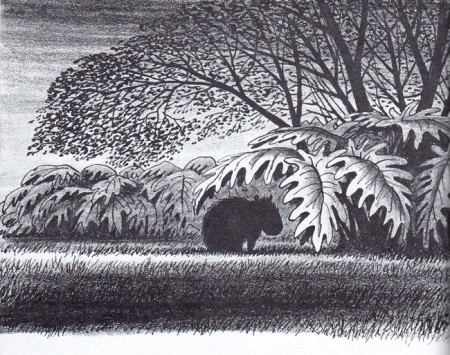 1
1We worried about Capy’s depression. He just sat there
doing nothing and couldn’t be pulled out of it.
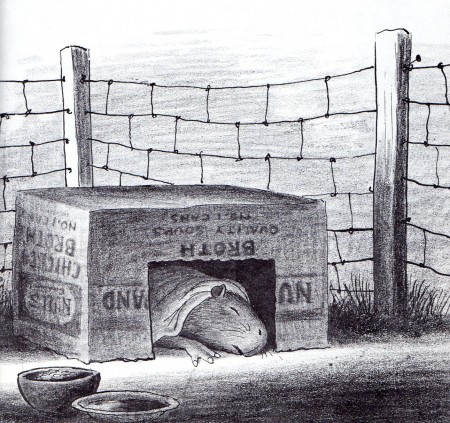 2
2
The same continued the next day. Steve was already there feeding him and
giving him water, but Capy didn’t move. We only knew he was alive by the breathing.
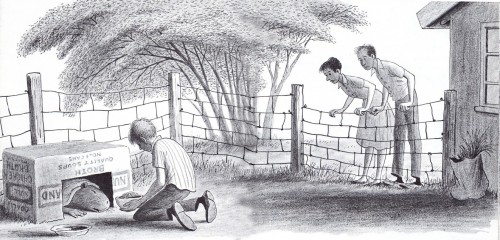 3
3
On the second morning, things remained the same. we heard from Tommy.
His head was better and he wasn’t mad at Capy for hurting him.
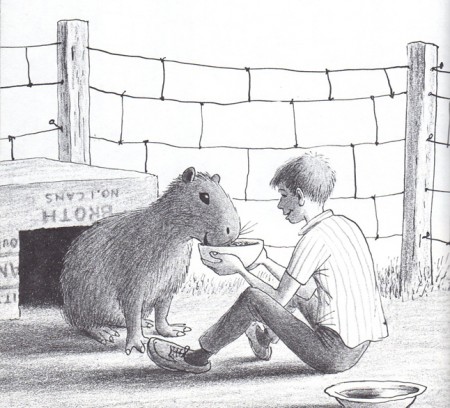 4
4
By the third day, Capy had gotten better. He sat up and was
drinking water and eating a little food. He seemed to be happy.
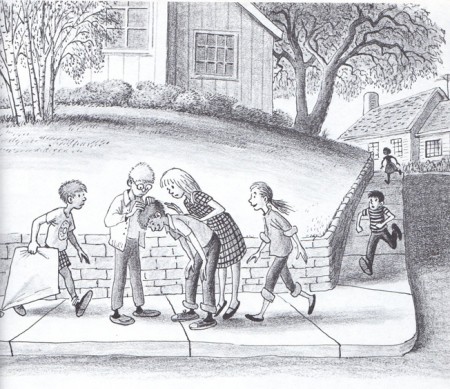 5
5
Meanwhile Tommy had become a local celebrity. His scar from Capy’s scratch
was a hit and every kid wanted to see. We were afraid other children would
want to be scratched by Capy and we began to think how we could avoid this.
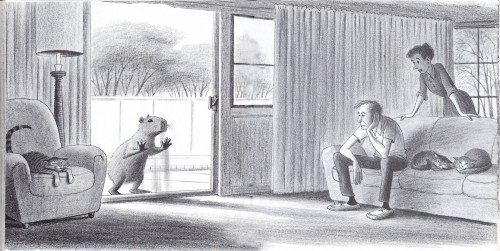 6
6
I suggested donating Capy to the Los Angeles Zoo.
Margaret said that’d be like sending him to prison. Why not send him
back to South America with a note that he should be released into the jungle?
Then she suggested we bring him there, ourselves.
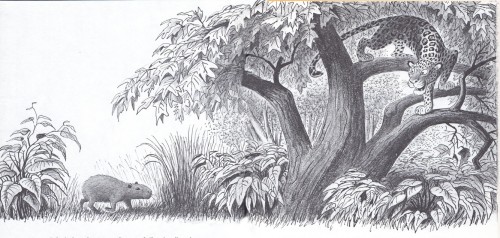 7
7
We agreed. But we worried that Capy wouldn’t survive in the jungle.
He’d want to play with the other animals, and they’d want to eat him.
At this point, Bill, our son, returned from Mexico.
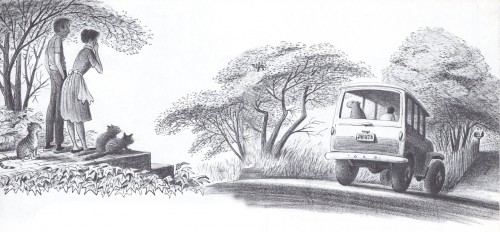 8
8
We discussed the problem with Bill and we tossed and turned
over the decision for many days. Finally, one day Bill picked up
Capy and put him into his jeep. He drove him to the Zoo.
Margaret cried, but aI reminded her that the Zoo was only a half-hour’s
drive away and we could visit him any time we wanted.
On the third visit, Capy shared his pen with a pair of huge hippos.
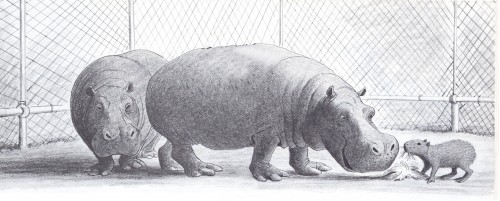 9
9
The zookeeper told us it wasn’t a mistake, and
Capy even rode around on their backs.
We watched as Capy and a hippo fought over some grass to eat.
The hippo won and we worried that Capy would go hungry in this pen.
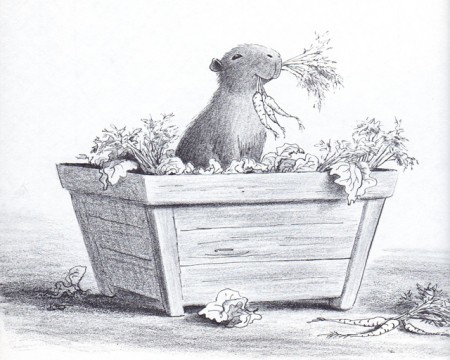 10
10
So we sat across the way on a park bench until feeding time.
The hippos were playing in the pool and Capy was having a feast.
We should have known the ultimately Capy would have his way.
If anyone was to have his way in the pen it’d be our Capyboppy.
This posting concludes Capyboppy. Many thanks to Bill Peckmann for introducing the book to me and sharing it with all of us.
Bill Peckmann &Books &Daily post &Peet 01 Apr 2011 07:32 am
Peet Sampler – 2
- Last week I posted samples from half of the Bill Peet books in Bill Peckmann‘s collection. Here, I give you a sampler of the other half. They add up to 26 books. Not bad considering 34 of them were published by Peet. This puts him just behind Maurice Sendak and Dr. Seuss as the third most prolific American children’s book author/illustrator.
As with the other Peet postings, I’ve eliminated the text from the illustrations. I hope this will encourage many of you to buy some of these books. Personally, I’d start with Bill Peet: An Autobiography.
Many thanks to Bill Peckmann, of course, for sharing.
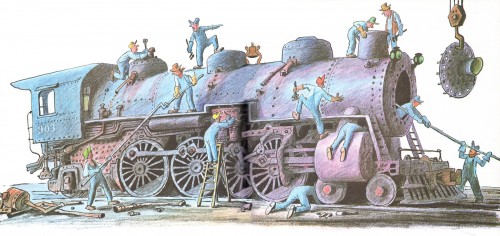 14
14The Caboose Who Got Loose – 1971
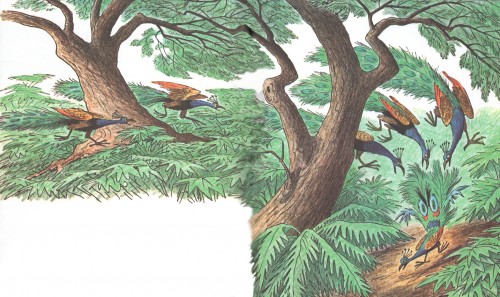 15
15
The Spooky Tail of Prewitt Peacock – 1973
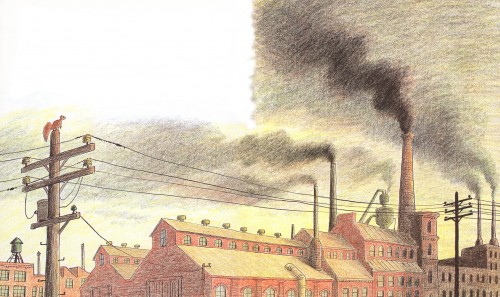 16
16
Merle the High Flying Squirrel – 1974
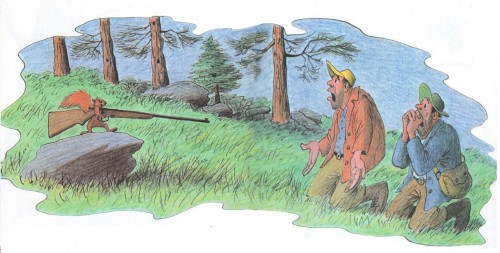 17
17
The Gnats of Knotty Pine” – 1975
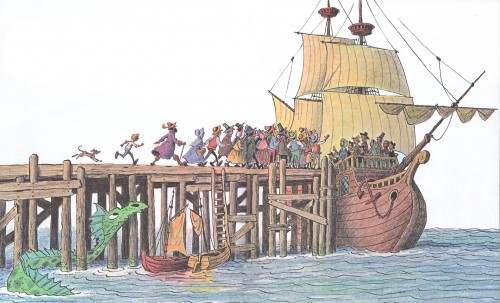 18
18
Cyrus the Unsinkable Sea Serpent – 1975
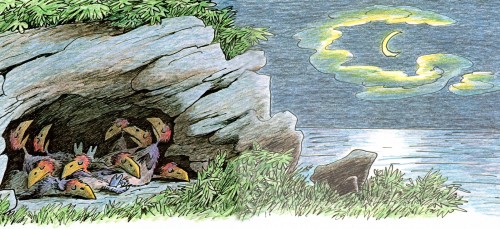 24
24
The Kweeks of Kookatumdee – 1985
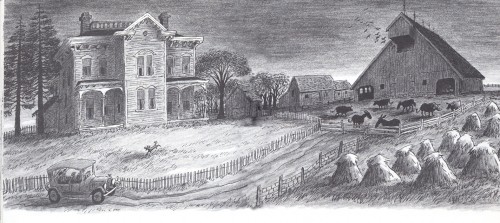 25
25
Bill Peet – An Autobiography – 1989 #1
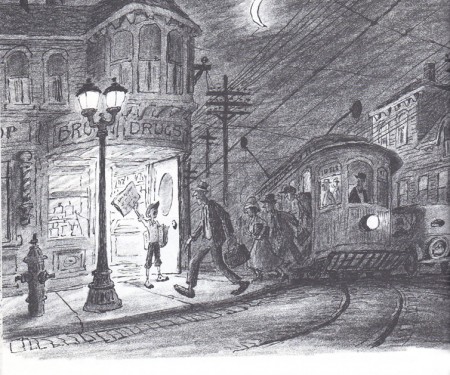
Bill Peet – An Autobiography – 1989 #2
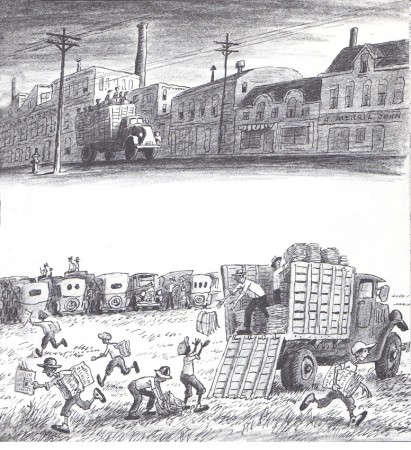
Bill Peet – An Autobiography – 1989 #3
Bill Peckmann &Books &Illustration 29 Mar 2011 07:36 am
The Unidentified Flying Elephant – pt. 1
 - Whitney Darrow Jr. has been one of the foremost gag cartoonists of our time. His work has appeared in The New Yorker magazine for over 50 years. His first cartoon appeared March 18, 1933 and produced of 1500 cartoons for them prior to his death on Aug. 112, 1999, just shy of his nintieth birthday. He was one of the cartoonists who wrote his own captions.
- Whitney Darrow Jr. has been one of the foremost gag cartoonists of our time. His work has appeared in The New Yorker magazine for over 50 years. His first cartoon appeared March 18, 1933 and produced of 1500 cartoons for them prior to his death on Aug. 112, 1999, just shy of his nintieth birthday. He was one of the cartoonists who wrote his own captions.
Bill Peckmann sent me scans of Darrow’s chldren’s book, The Unidentified Flying Elephant. The drawings are crisp and strong, done in the same wonderful style as his gag cartoons. Although, here, he is workng with color. Robert Kraus wrote the text. (Whitney Darrow Jr. has a large collection of books he illustrated usually partnering with another author.)
The following is the first half of the book:
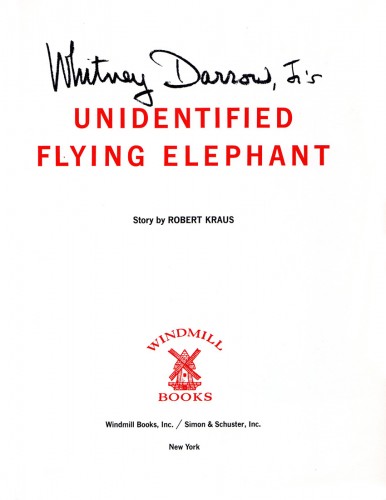 1
1
Many thanks to Bill Peckmann for the material to display.
Bill Peckmann &Books &Illustration &Peet 25 Mar 2011 07:41 am
Peet Sampler – 1
- Bill Peckmann owns 26 of the children’s books by Bill Peet. We’re coming to the finish of posting his beautiful book, Capyboppy, and we thought as a follow-up it’d be best to post a sampler from each of these 26 books. We’ve taken a double page spread from each that Bill has scanned and forwarded to me. I’ve done my best in photoshop to link the two together.
Here, in chronological order, are the first 13 of the books in Bill’s collection. By putting them in order, we can see the development and growth of his illustration style.
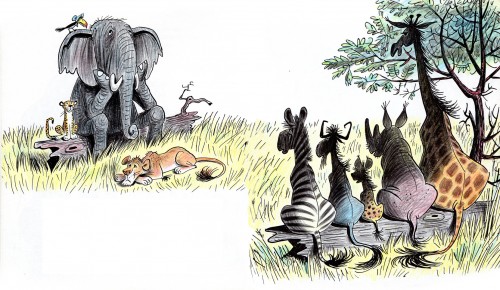
“Hubert’s Hair-Raising Adventure” – 1959
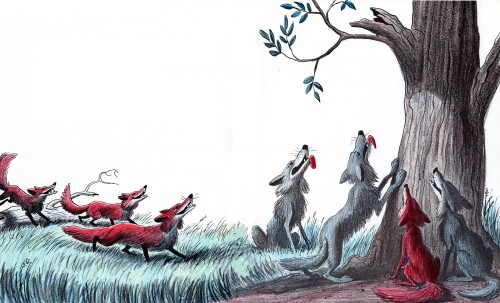
“The Pinkish, Purplish, Bluish Egg” – 1963
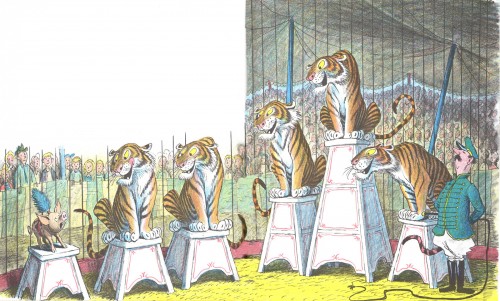
“Chester, the Worldly Pig” – 1965
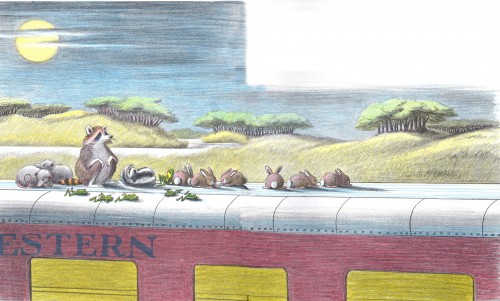
“Farewell to Shady Glade” – 1966
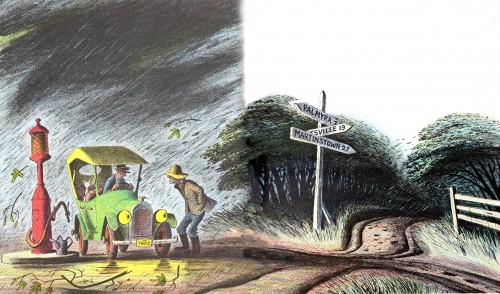
“Jennifer and Josephine” – 1967
Books &Commentary 24 Mar 2011 07:15 am
Disney books
- Lately, Disney’s book divisions have done some wonderful work. The Archive series: Animation, Story, Design and soon to come Layout & Bg are all stunningly attractive books. These are top of the line items from Disney Editions. John Canemaker‘s Two Guys Named Joe also comes from the same division, and it’s a beautifully designed and attractively produced book.
But what about the lower end of the Disney Publishing empire? In the bygone days the animated features would be made into Little Golden Books utilizing artists from the studio. Mary Blair, Al Dempster, Bill Peet, and Eyvind Earle all contributed to books for the Western Publishing offshoot. Today there are still some Little Golden Books being made from Disney material. The Pixar product, such as Toy Story and Wall-E, as well the Disney Princesses and The Princess and the Frog all have editions.
However, I came upon something even lower down the pipeline. Here are three books that were produced for Walgreen’s pharmacy megastores. Heidi bought them 3 for $3.98. None of the books gives a hint of illustrator or writer. The illustrations, on a very cursory glance, look as though they might have been frame grabs pulled from the movies.
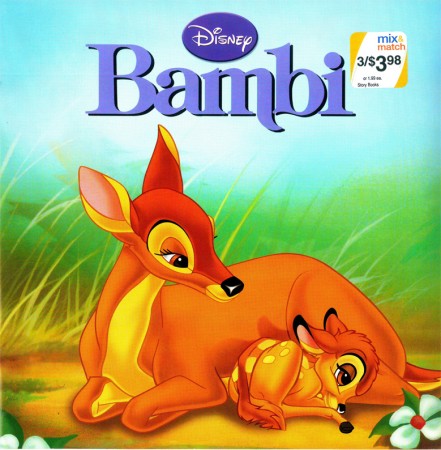
Bambi’s cover. It’s a nice watercolor evocative of the film. Though one
wonders why they played with the logo’s type. The “m” now has a
little swoosh on its lower right. Not part of any other version of this title.
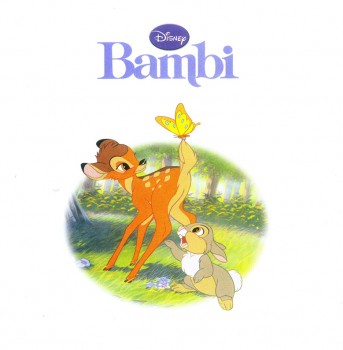
Our first interior illustration looks like it might
have been a frame grab from the film, itself.
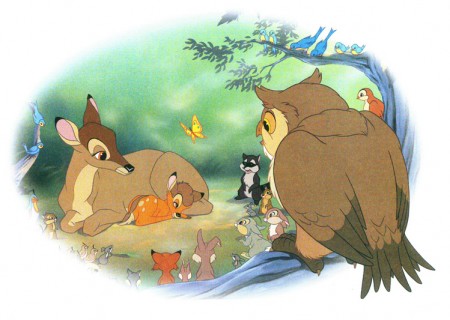
This tries hard to look like it might have come from the film.
But all the characters are moved around differently.
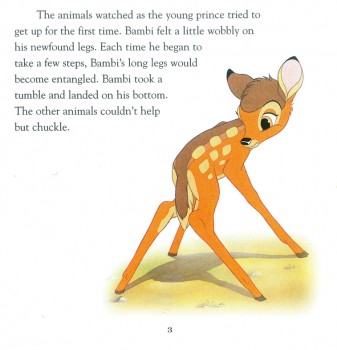
They do a nice job of layout using this iconic image against the type.
Looking at this book, I’m amazed how many well-know still images there
are in the original feature. Those old guys knew what they were doing.
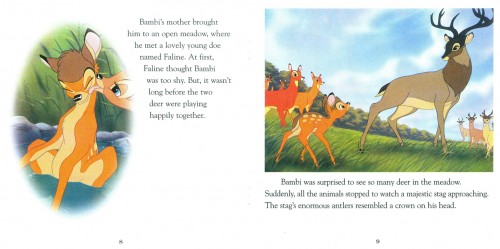
Here are a couple of double page spreads. I like the way they
handle them in these books. You can see that there is a plan.
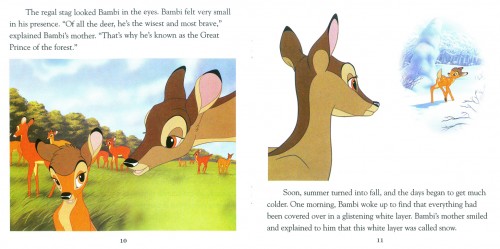
By now, the illustrations look more like Bambi 2 than the original.
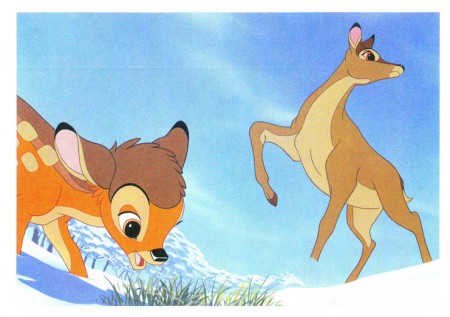
The characters were obviously done on separate levels. Notice the
mother’s leg doesn’t match the background. She’s out of place.
Something you might have seen back in the days with the use of cels.
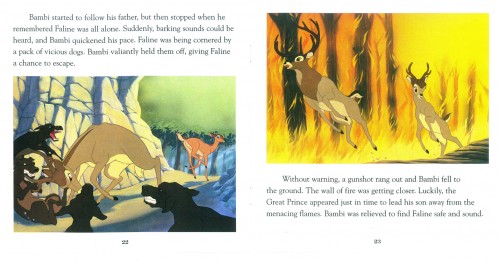
Two pages covers the climax of the film, Faline’s encounter
with the dogs and the fire rates one illustration.
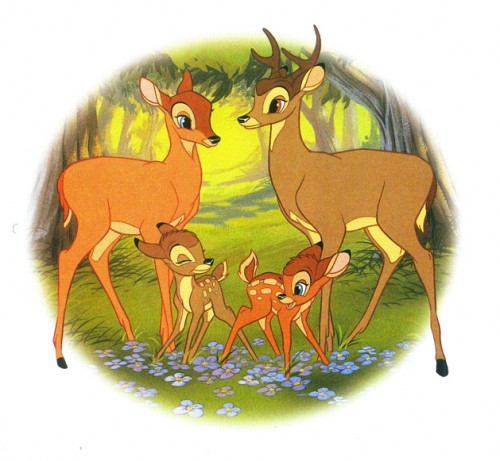
The final illustration takes us into “Bambi’s Children” and
has nothing to do with the original film, anymore.
Peter Pan
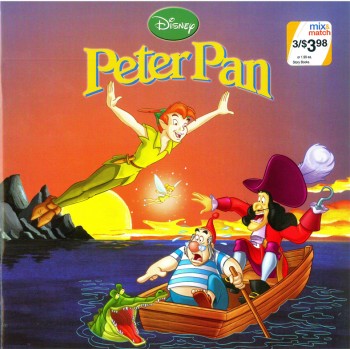
Peter Pan gets off to a bad start with a RED cover
and an action illustration. Not quite the film.
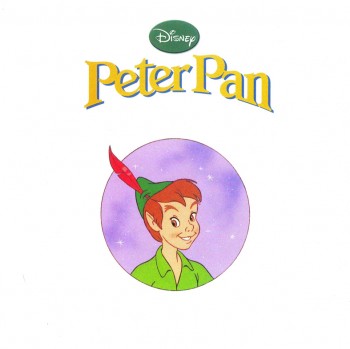
Get to the title page, and Peter is WAY off model.
Oh well.
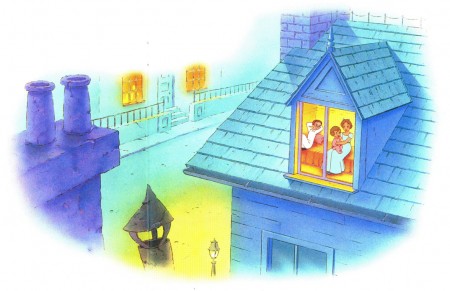
When I think of that beautiful opening shot in the film, it isn’t
quite this. I’m afraid, the Bambi book will be the best of the lot.
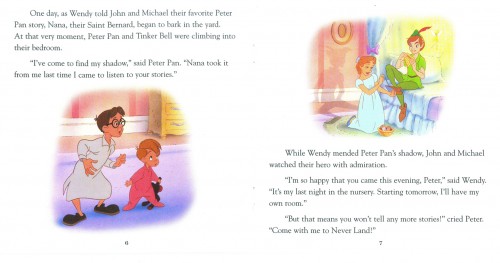
The double-page spreads do still play a bit with the form.
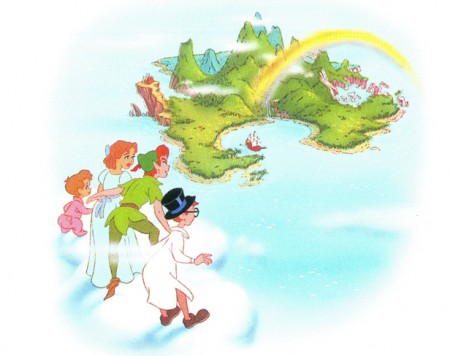
Not much magic left in this Neverland.
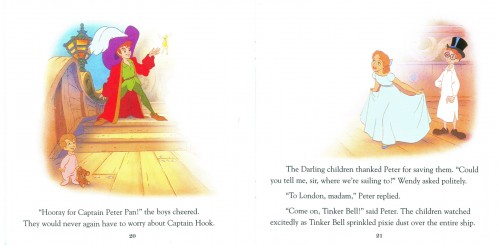
Most of the book is done in Long Shots. I’d say that’s
not the best choice for smallish illustrations. And the
airbrushed white is too opaque to work as a border; it
gets to look like a virus in the air.
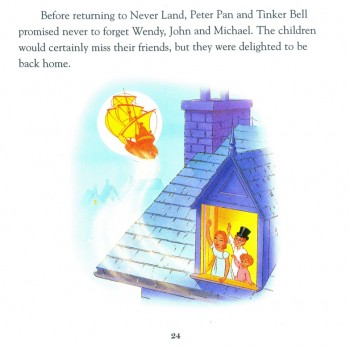
The book is too much on the red side. Everything here is
violet and yellow. Not quite the colors invoked by the
orinal designers.
101 Dalmatians
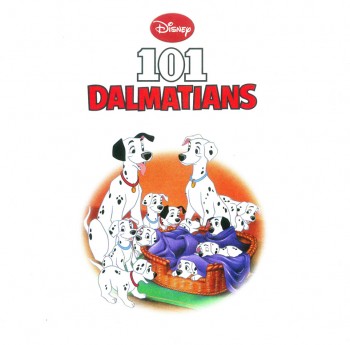
The title page makes for a good composition with bad colors.
The technique, using gouache starts to peek through.
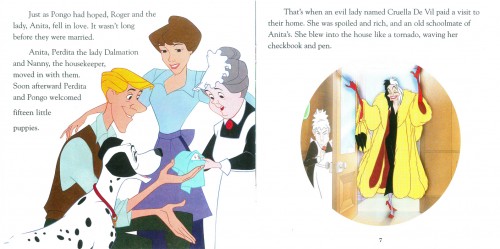
They’ve captured the pose and lost the film.
Where’s that beautiful cut-glass rose in the door?
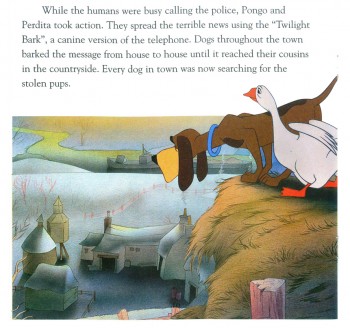
Too bad they’ve ignored the wonderful background styling
of Ken Anderson and the painting of Walt Peregoy.
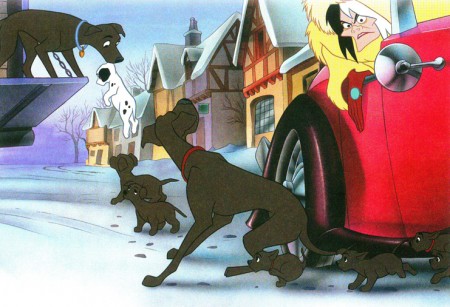
A lot of action. Not a bad image though Cruella’s been simplified.
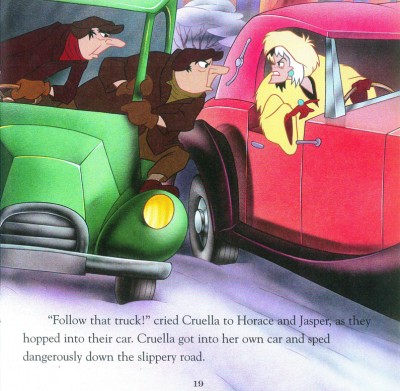
We’ve ignored the great design of the film and have gone to “storybook 2009″.
(The books were done in 2009.)
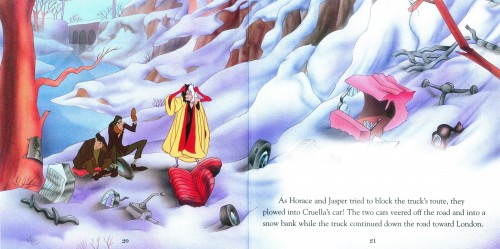
The two page spread makes use of its format, I have to say that.
All in all, I’d have to say it’s probably not a bad deal for parents looking for cheap books to entertain their children. The Bambi book holds up nicely. Peter Pan wastes a great story and 101 Dalmatians works hard to reduce their story into a small book you’d buy in a drug store.
The art and delicacy of the Little Golden Books is gone. Take a look at this, or this, or this. They all varied wildly from the film, but with a sense of originality and design. These three Walgreen books all try doggedly to resemble the film while losing the artistry in the book.
Bill Peckmann &Books &Peet 22 Mar 2011 07:48 am
Peet’s Capyboppy – Part 3
- Continuing my posting the fine illustrations by Bill Peet for his book, Capyboppy we go to the third part. As I’ve written with the first two parts, I’m not including Bill Peet’s text; I prefer just to focus on his illustrations. However, I do synthesize the story so that the illustrations make sense.
So, here are those illustrations which Bill Peckmann scanned from his copy of the book:
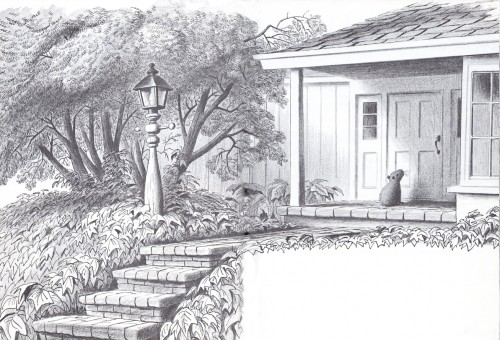 1
1Capy sat on the front porch waiting for us to let him in.
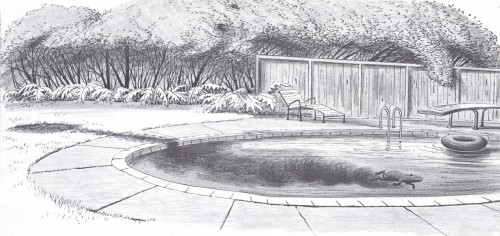 2
2
He got into the habit of rolling in the mud and
getting into the pool to clean off. This made
the pool a dirty brown color. We solved this
problem by putting an old inner tube onto the
mudwallow, which Capy grew interested in.
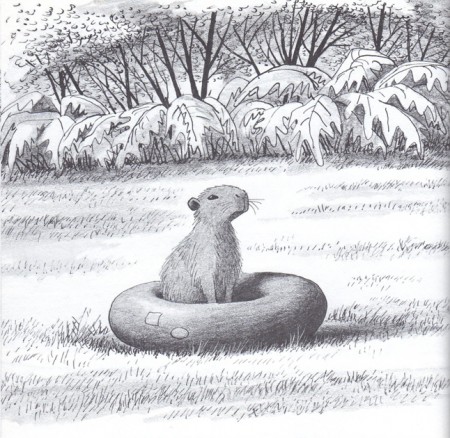 3
3
Capy settled into the inner tube and was irritated
that he couldn’t get to his mudwallow.
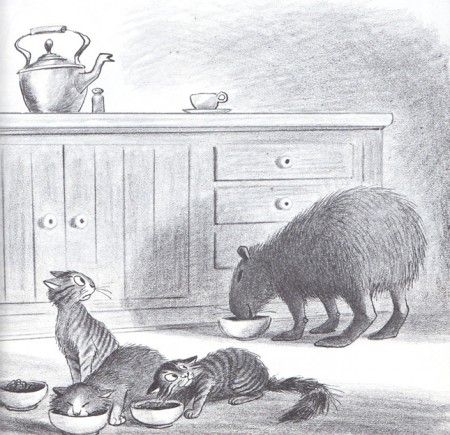 4
4
He was getting to be headstrong.
He ate more and grew bigger.
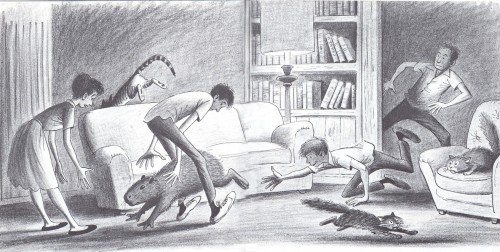 5
5
Capy still rested on the sofa in evenings, however he started to get smart.
When he knew it was bedtime, he’d jump onto the ground and raced down
the hall. Just when we’d cornered him and were about to catch him,
he’d slip our grasp.
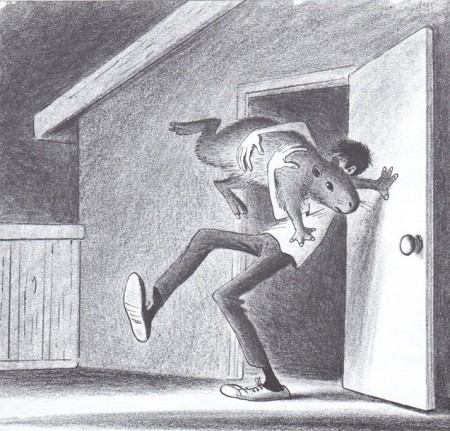 6
6
Even when we caught him, he was a handful
kicking, scratching and tossing about.
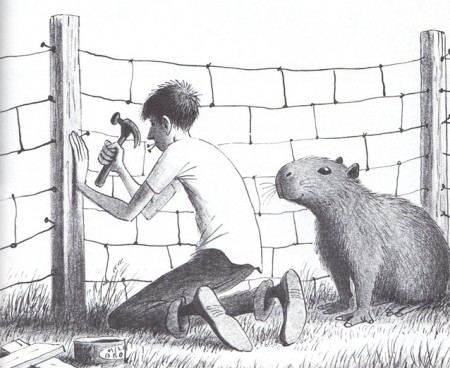 7
7
Bill helped build a pen to safely lace him in, and then
our son left to go on a month-long trip to Mexico.
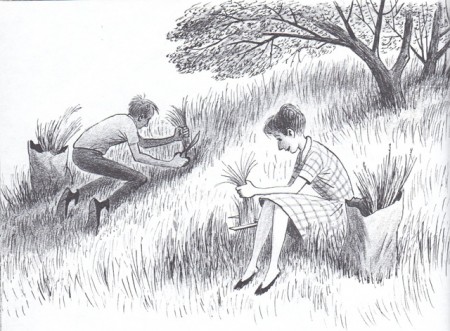 8
8
We used fresh grass that was gathered on the hill
to lure Cappy back into his pen.
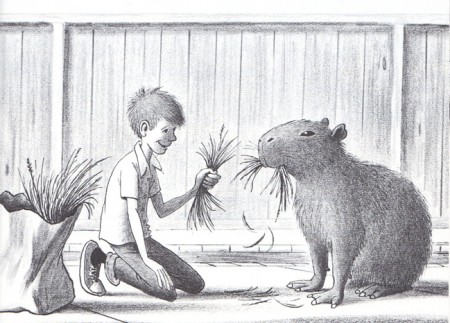 9
9
One day we allowed him to eat more than a handful.
A young friend, Tommy, kept feeding Cappy who finally
jumped at Tommy and scratched him on the head.
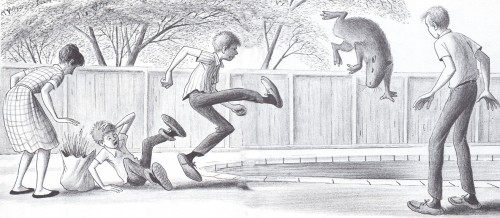 10
10
Tommy screamed and shouted and Capy lept into the pool and
settled on the bottom. Tommy was taken to the hospital and
I went to keep an eye on Cappy.
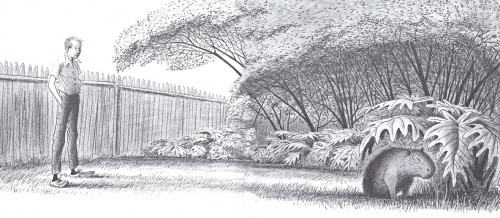 11
11
Cappy had settled in the bushes not moving. I wondered what
had caused his sudden anger, but wondered if it weren’t sudden.
Maybe he’d been building up his resentment of humans. He was a
sensitive animal. Perhaps, in some way he thought he was being
punished. Tommy returned from the hospital and
I turned to find out what news they had.
Again, many thanks to Bill Peckmann for scanning the book.
Books 17 Mar 2011 08:15 am
Fire Dog
- Fire Dog is a book from Whitman Publishing. It’s not a “Little Golden Book” (Western Publishing), but it sure looks like one in many ways. The book was written by Lee Julian and illustrated by Charles Clement. Clement made a name for himself with a version of The Night Before Christmas. Fire Dog is the sequel to Dally, the successful 1951 book by the pair.
I’ve decided to post all of the illustrations. The type is built into the layout (sometimes becoming part of the illustrations) so I include the type in the post.
Here are all the images, posted as double-page spreads.
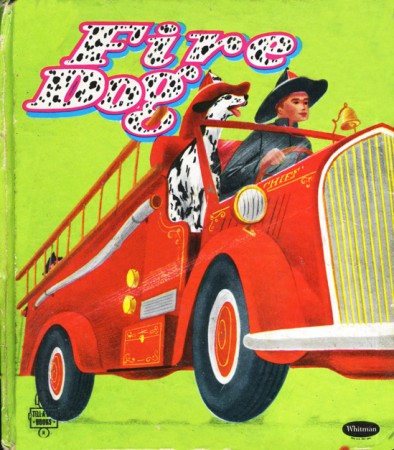
The well-worn book’s cover.
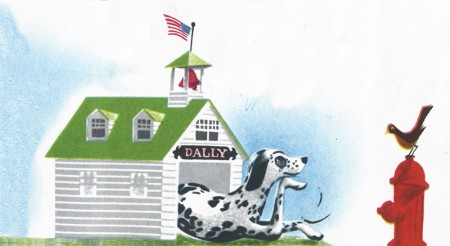
A closeup of the illustration.
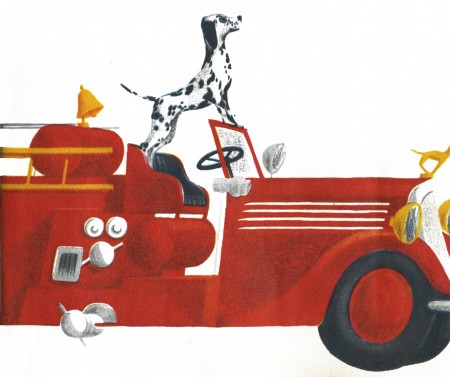
A closeup of the illustration.
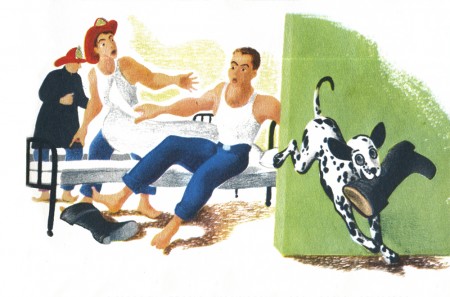
A closeup of the illustration.
Bill Peckmann &Books 04 Mar 2011 08:15 am
Peet’s Capyboppy – 1
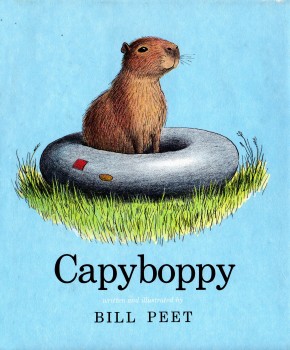 - Bill Peckmann has been sending scans of Bill Peet’s book, Capyboppy. This is about a 60 page book which includes a lot of B&W illustrations.
- Bill Peckmann has been sending scans of Bill Peet’s book, Capyboppy. This is about a 60 page book which includes a lot of B&W illustrations.
I don’t think it particuly ethical to post the illustrations AND the writing. Consequently, I’ve decided to post the illustrations as stand-alone without the text.
Since the illustrations don’t make much sense without the story, I’m adding a short synopsis as we go. I encourage you, if you like it, to get the book. It’s a gem. you can buy a paperback copy from Amazon for very little money.
The book has a similar feel to Bill Peet An Autobiography, one of the best books of its kind around. I must have read that book about a dozen times since buying it years ago. Prior to publishing this book, Peet wouldn’t reveal his connection to the Disney studio in his encapsulated bios found on the back flyleaf of his children’s books. He wanted a separation from the studio and got it.
The man was a genius who brought so much to the films he worked on, yet tried to separate himself from that work.
Here’s the first part of Capyboppy:
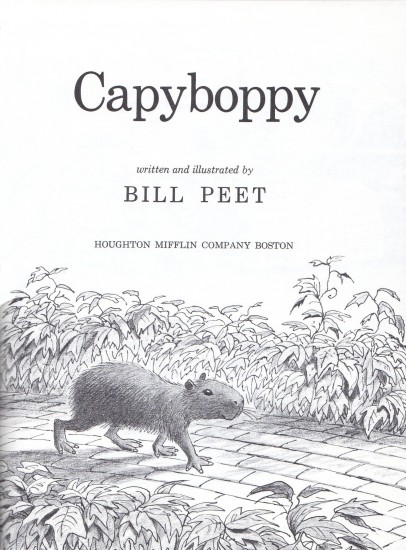 3
3
This story tells of the author’s son, Bill. Bill collected wild animals:
tarantulas, mantises. lizards, the like. Usually, one would replace another
as Bill grew older. When he moved off to college, Bill wanted a boa, but
the family was afraid of the boa escaping and eating the three pet cats.
Bill agreed not to get a boa but asked if it were all right to get a capybara.
A capybara is the world’s largest rodent sometimes getting up to 200 pounds in weight.
It was agreed and Bill placed the order. When it arrived, Bill drove it up to the door
in his jeep. The capybara jumped out and waddled into the house making sounds like
a bird, “tweedle-tweet.” This aroused the curiosity of the three cats, but when they
saw the big fella, the cats all jumped and ran.
The capybara ignored them and went straight to the kitchen and
ate their food. One would expect the vegetarian rodent to turn is
nose away from the cat food, but he ate all three bowls worth.
He was just five months old now, what would he be like when he grew?
After eating the cat food as well as some oats and barley he roamed about the house
with the family following. “Tweedle-tweet.” As he went about the house, he was
not just investigating. He’d take a bite out of everything.
The family decided to move him to the back yard.
To be continued.
Many thanks to Bill Peckmann for sharing this great work.
